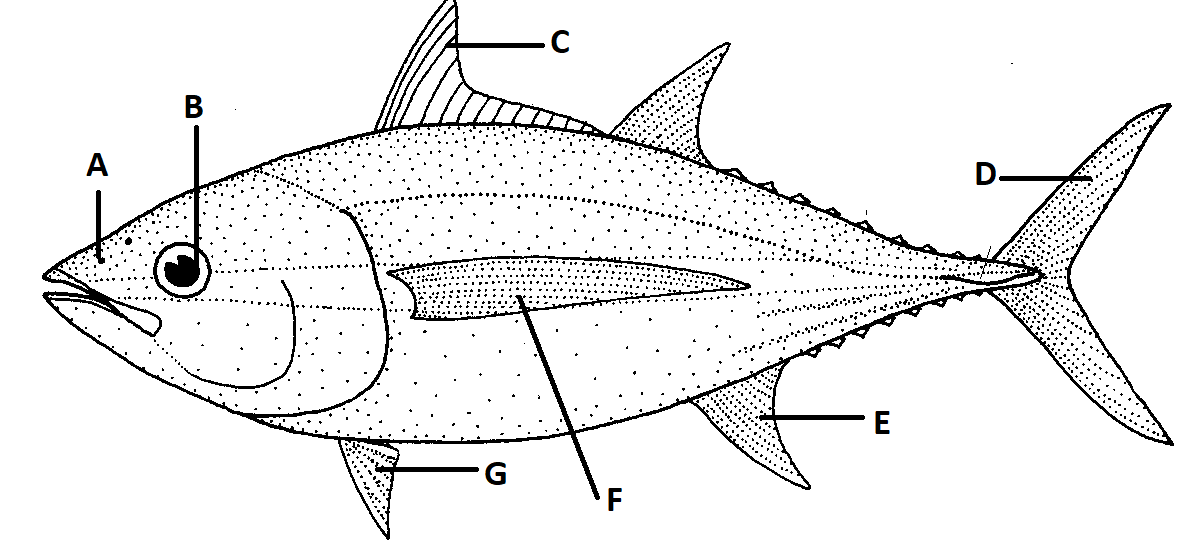
The diagram of Labeo rohita is given below. Identify the parts labelled as A. B. C. D. E. F. G respectively.

A. A- Stimulus. B - Receptor nerve. C - Sensory nerve. D - Motor. E - Effector nerve. F - Pectoral fin. G - Pelvic fin
B. A - Nostril. B - Eye. C - Anal fin. D - Caudal fin. E - Dorsal fin. F - Pectoral fin. G - Pelvic fin
C. A- Nostril. B - Eye. C - Dorsal fin. D- Caudal fin. E - Anal fin. F - Pelvic fin. G - Pectoral fin
D. A - Nostril. B - Eye. C - Dorsal fin. D - Caudal fin. E - Pectoral fin. F - Anal fin. G - Pelvic fin

Answer
408k+ views
Hint: The carp-like roho labeo can be found in rivers throughout South Asia. It's a huge omnivore with a lot of uses in aquaculture. The rohu can be found in rivers all over northern, central, and eastern India.
Complete answer:
-The operculum is the cover that protects the fish's mouth, nose, and gills.
-The fish's nose is A, and the fish's eye is B.
-Fins consist of stiff rays or scales that are coated in skin. It aids the fish in swimming. Fins such as dorsal, caudal, and lateral fins are seen on the fish. The dorsal fin is the side fin of a fish that offers stability while swimming. The caudal fin, also known as the tail fin, is the main propulsive fin and is located near the back of the animal. This fin aids in shifting swimming directions.
-The dorsal fin is C, and the caudal fin is D.
-Fins are often used as foils to provide lift or push, or to steer or stabilise motion while travelling in water, air, or other fluids. Fins can also be utilised to improve surface areas for heat transmission or as decorative elements. Fins evolved as a mechanism of propulsion for fish.
-Another form of fin that helps with swimming stability is the anal fin. The anal fin is denoted by the letter E.
-The anal fin is present on the ventral side of fish, usually at the base of the anus, but not always. The anal fin, like the dorsal fin, serves to support the fish and prevent it from rolling around in the water.
-The pectoral fins aid in propulsion and movement from side to side. The letter G stands for pectoral fin.
As a result, option C is the proper response.
Note: Rohita labeo Rohu, also known as Carpo fish, contains a significant amount of protein. Omega 3 fatty acids, as well as vitamins A, B, and C, are abundant. At least once a week, you should eat Rohu.
Complete answer:
-The operculum is the cover that protects the fish's mouth, nose, and gills.
-The fish's nose is A, and the fish's eye is B.
-Fins consist of stiff rays or scales that are coated in skin. It aids the fish in swimming. Fins such as dorsal, caudal, and lateral fins are seen on the fish. The dorsal fin is the side fin of a fish that offers stability while swimming. The caudal fin, also known as the tail fin, is the main propulsive fin and is located near the back of the animal. This fin aids in shifting swimming directions.
-The dorsal fin is C, and the caudal fin is D.
-Fins are often used as foils to provide lift or push, or to steer or stabilise motion while travelling in water, air, or other fluids. Fins can also be utilised to improve surface areas for heat transmission or as decorative elements. Fins evolved as a mechanism of propulsion for fish.
-Another form of fin that helps with swimming stability is the anal fin. The anal fin is denoted by the letter E.
-The anal fin is present on the ventral side of fish, usually at the base of the anus, but not always. The anal fin, like the dorsal fin, serves to support the fish and prevent it from rolling around in the water.
-The pectoral fins aid in propulsion and movement from side to side. The letter G stands for pectoral fin.
As a result, option C is the proper response.
Note: Rohita labeo Rohu, also known as Carpo fish, contains a significant amount of protein. Omega 3 fatty acids, as well as vitamins A, B, and C, are abundant. At least once a week, you should eat Rohu.
Recently Updated Pages
The correct geometry and hybridization for XeF4 are class 11 chemistry CBSE

Water softening by Clarks process uses ACalcium bicarbonate class 11 chemistry CBSE

With reference to graphite and diamond which of the class 11 chemistry CBSE

A certain household has consumed 250 units of energy class 11 physics CBSE

The lightest metal known is A beryllium B lithium C class 11 chemistry CBSE

What is the formula mass of the iodine molecule class 11 chemistry CBSE

Trending doubts
Is Cellular respiration an Oxidation or Reduction class 11 chemistry CBSE

In electron dot structure the valence shell electrons class 11 chemistry CBSE

What is the Pitti Island famous for ABird Sanctuary class 11 social science CBSE

State the laws of reflection of light

One Metric ton is equal to kg A 10000 B 1000 C 100 class 11 physics CBSE

Difference Between Prokaryotic Cells and Eukaryotic Cells




